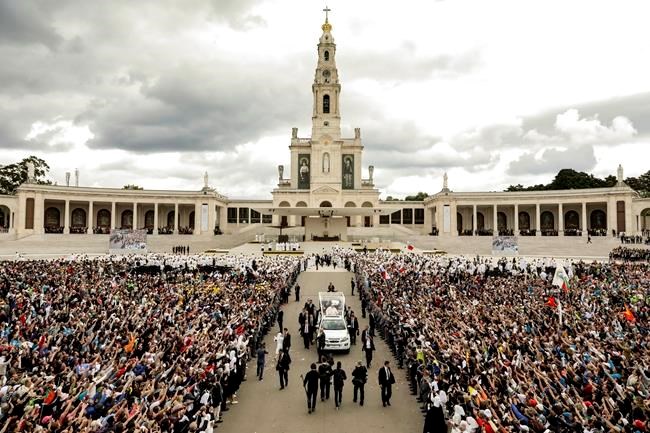VATICAN CITY (AP) — The Vatican on Friday radically reformed its process for evaluating alleged visions of the Virgin Mary, weeping statues and other seemingly supernatural phenomena, insisting on having the final say in whether the events are worthy of popular devotion.
The Vatican’s doctrine office overhauled norms first issued in 1978, arguing that they were no longer useful or viable in the Internet age. Nowadays, word about apparitions or weeping Madonnas travels quickly and can actually harm the faithful if hoaxers are trying to make money off people's beliefs or manipulate them, the Vatican said.
The new norms reframe the Catholic Church’s evaluation process, by essentially taking off the table whether church authorities will declare a particular vision, stigmata or other seemingly divinely inspired event supernatural.
Instead, the new criteria envisages six main outcomes, with the most favorable being that the church issues a noncommittal doctrinal green light, a so-called “nihil obstat.” Such a declaration means there is nothing about the event that is contrary to the faith, and therefore Catholics can express devotion to it.
The revised norms allow that an event might at some point be declared “supernatural” – and that the pope can intervene in the process. But “as a rule,” the church is no longer in the business of authenticating inexplicable events or making definitive decisions about their supernatural origin.
The Catholic Church has had a long and controversial history of the faithful claiming to have had visions of the Virgin Mary, of statues purportedly weeping tears of blood and stigmata erupting on hands and feet mimicking the wounds of Christ.
When confirmed as authentic by church authorities, these otherwise inexplicable divine signs have led to a flourishing of the faith, with new religious vocations and conversions. That has been the case for the purported apparitions of Mary that turned Fatima, Portugal and Lourdes, France into enormously popular pilgrimage destinations.
Church figures who claimed to have experienced the stigmata wounds, including Padre Pio and Pope Francis’ namesake, St. Francis of Assisi, have inspired millions of Catholics even if decisions about the authenticity of them has been elusive.
Francis himself has weighed in on the phenomenon, making clear that he is devoted to the main church-approved Marian apparitions, such as Our Lady of Guadalupe, who believers say appeared to an Indigenous man in Mexico in 1531.
But Francis has expressed skepticism about more recent events, including claims of repeated messages from Mary to “seers” at the shrine of Medjugorje, in Bosnia-Herzegovina, even while allowing pilgrimages to take place there.
“I prefer the Madonna as mother, our mother, and not a woman who’s the head of a telegraphic office, who sends a message every day at a certain time,” Francis told reporters in 2017.
But the phenomena has also been a source of scandal. That was the case when the Vatican in 2007 excommunicated the members of a Quebec-based group, the Army of Mary, after its foundress claimed to have had Marian visions and declared herself the reincarnation of the mother of Christ.
The revised norms acknowledge the potential for such abuses, and warn that hoaxters will be held accountable, including with canonical penalties. The new norms warn that claiming mystical experiences for profit or as a means to control others or to commit abuses against them “is to be considered of particular moral gravity.”
The new norms envisage a more articulated investigation process after a bishop receives word of a possible supernatural event in his diocese. He forms a study commission of theologians and canon lawyers to gather information and evidence, interview the alleged witnesses and come to a recommendation that he submits to the Vatican’s Dicastery for the Doctrine of the Faith for approval.
He can choose among six general outcomes: the green light “nihil obstat” to allow and even encourage popular devotion, or gradually more cautious approaches if there are doctrinal red flags about the reported event. The most serious envisages a declaration that the event isn’t supernatural or that there are enough red flags to warrant a public statement “that adherence to this phenomenon is not allowed.”
Whereas in the past the bishop often had the last word unless Vatican help was requested, now the Vatican must sign off on every recommendation proposed by a bishop.
In an explanatory note, the head of the Vatican’s doctrine office, Argentine Cardinal Víctor Manuel Fernández, acknowledged that the Vatican’s previous way of handling reported apparitions often led to “considerable confusion” among the faithful.
That confusion has been laid bare even in recent times concerning the purported visions of the Madonna at a Carmelite convent in Lipa, Philippines, which were said to have been accompanied by a shower of rose petals.
In 1951, Pope Pius XII confirmed a decision by the then-Holy Office that purported visions had “no sign of supernatural character or origin.”
The Vatican came to that decision after the convent prioress confessed to having participated in the “deception” at Lipa, and some of her nuns testified that they had seen deliveries of roses to the convent and had received orders from the prioress to burn the petal-less stems.
But for decades, Filipino bishops glossed over the definitive nature of the Vatican ruling after the Vatican urged them to keep its role in the evaluation quiet. So the bishops suggested in their communications to the faithful that the jury was still out, according to documentation made public last year by the Filipino bishops conference.
As a result, some Filipino faithful continued to venerate the image of the Madonna at Lipa, prompting the Vatican in a series of increasingly exasperated decrees to demand that the Lipa archbishop heed the original 1951 ruling and put an end to the devotional events.
The latest decree, from July of last year, demanded the Lipa archbishop cancel plans to commemorate the 75th anniversary of the purported apparitions, saying “it would not be advisable for you to authorize the aforementioned celebration under any form.”
Nicole Winfield, The Associated Press

